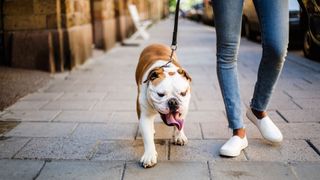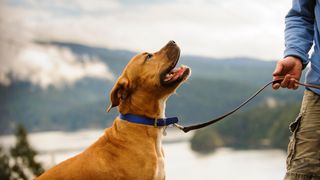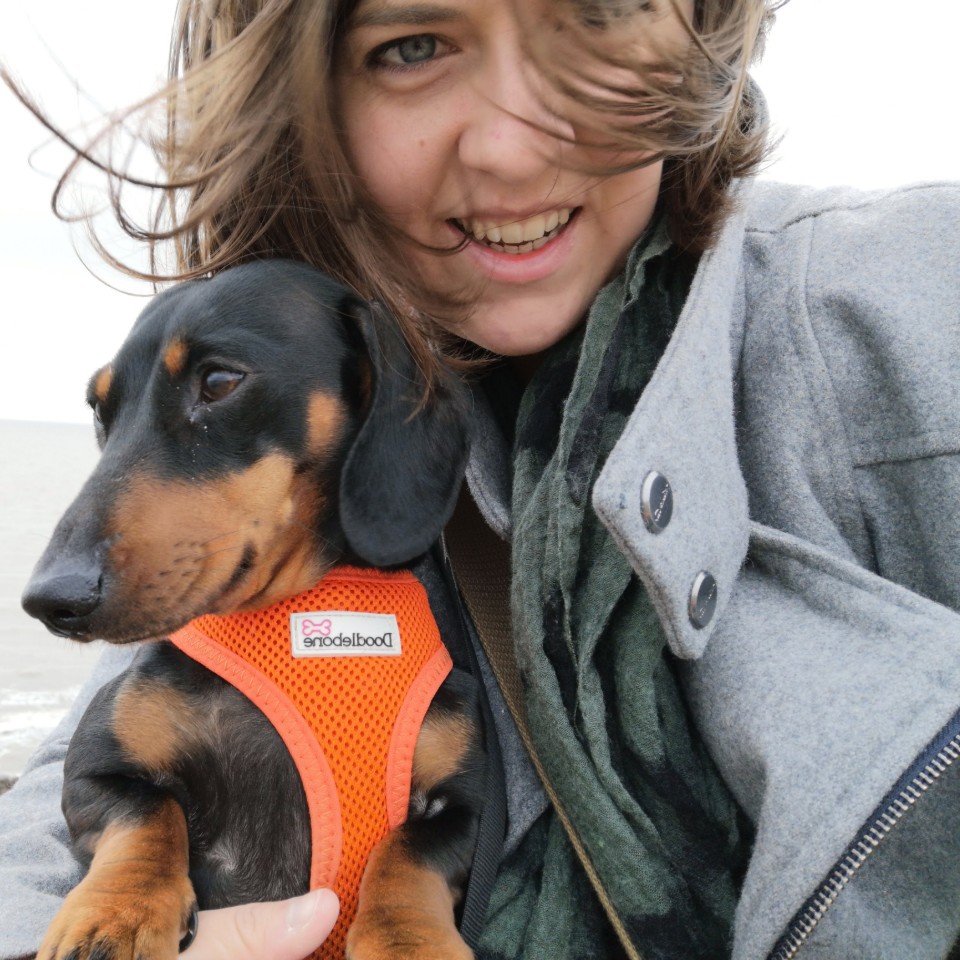How to stop a dog from pulling on a leash
Want to learn how to stop a dog from pulling on a leash? These top tips will have your canine companion calmly walking by your side in no time

Figuring out how to stop a dog from pulling on a leash is one of the fundamental things every puppy owner will face at one point or another.
Getting to the point where your dog will walk calmly by your side can take a little patience and perseverance, but the rewards are numerous - for both you and your canine companion.
In this piece we’ll be taking a look at why dogs pull on their leads in the first place, and some simple tips you can try to help train your dog to be better next time you head out for walkies.
Why do dogs pull on their leash?
There can be several reasons why your dog is pulling on their lead. One of the big reasons can be sheer excitement to get where they’re going (say if it’s your daily visit to the park for a game of fetch), but ultimately, it’s a learned behavior that has always reaped rewards in the past - so they’ll continue doing it.
It’s important to teach your dog to walk correctly as soon as you can. Those with bigger dogs will find it especially difficult as the dog gets older, larger and stronger to walk a dog if it’s not done in a calm and careful manner. That said, even those with smaller and lighter dogs should be considerate of pulling as it can cause problems for your dog even if it’s not such an issue for the walker.
Essentially, if a dog has learned that pulling gets them what they want - i.e. they get to move forward, they’ll continue to do it unless they’re trained otherwise. Luckily, it’s relatively straightforward to teach most dogs the correct way to walk, so long as you have the patience and perseverance to do so.
If you can, start training your dog from as young as possible, but it’s not too late to correct older dogs who have gotten into bad habits - almost all dogs (and their humans) can learn from these simple tips.
How to stop a dog from pulling on a leash
These are basic tips that you can use for most situations, but we’ll also cover a couple of specific scenarios in the following sections if you’ve got a certain kind of issue with your pup.
1. Choose your equipment
This might seem like an odd tip, but there’s actually quite a lot of different types of “walking” equipment you can get for a dog these days.
There’s a simple lead and collar set up, harnesses, slip leads, training leads and more. What works for your dog might not work for another one, so spend some time carefully looking into the benefits of each kind of lead, and how much you want to spend.
That said, if you have a dog with a propensity for pulling, using the best dog harness can be a good idea as pulling while the lead is attached to a collar can be very uncomfortable for the dog. Once you’ve made good progress with training the dog to walk without pulling, you might consider moving towards a collar only, but it’s worth considering starting with a harness.
A harness is also useful if you need to quickly grab your dog to move them out of harmful situations. Slip leads and training leads can be a good idea for certain breeds, especially larger and harder to manage dogs, but we’ll discuss these in more detail later in the piece.
2. Train them at home first
As with any training situation, if there’s a lot of distractions (other dogs, traffic noise, people, squirrels), you’ll make it a lot harder on yourself if you attempt your first training sessions in the great outdoors.
It’s a good idea to train your dog at home first to get them used to the idea. This means teaching them to stay closely by your side, pay attention to commands, follow your eyes and stop moving when you expect them to.
At home, reward your dog when it stays by your side, and once you’re confident that they’ve cracked that, attach their lead, and simply move around your house and garden, rewarding the behavior that you want.
3. Make sure you’ve got plenty of time

When you’re ready to take your dog on a proper walk outside, make sure you allow plenty of time and don’t try to combine it with other things, or do it at a time that you need to be back quickly.
Having plenty of time will create a much more relaxed atmosphere, which will help with training and won’t lead to you feeling frustrated when the dog isn’t necessarily behaving exactly as you want them to.
4. Stop walking when they pull
When out, as soon as your dog pulls inappropriately, simply stop walking. Don’t scold your dog, and don’t pull the lead backwards - just stop moving.
As soon as you feel the dog’s lead slacken and they’re coming back towards you, calmly and quietly carry on moving. Repeating this pattern over and over again will teach them that they will get to move forward if they do it calmly and without pulling, and that pulling will only lead to stopping altogether.
If you find that your dog is pulling to get away even when you’ve stopped, you could try turning around and going in the opposite direction - again, this is teaching the dog that they won’t get what they want by pulling.
5. Always use the same training techniques
As is usually the case with dogs, consistency is hugely important. Following the routine above each time you go for a walk should teach your dog how to behave as quickly as you can.
There will of course be times when you don’t have time to stop every time the dog is pulling, but if you can avoid this as much as possible then you should reap the benefits.
6. Be patient!
It can be frustrating working with a dog who consistently wants to pull on a lead - but being calm yourself and keeping to a routine will pay off in the long run. Don’t give up!
How to train a dog to walk on a leash beside you

Once you’ve cracked the pulling, the next thing you might want to do is to get your dog to always walk beside you. This can be beneficial for ensuring that they don’t disturb other sidewalk users, and for keeping them away from other dangers - such as cars or other dogs.
A simple way to start training your dog to do this is to reward them whenever they are walking directly by your side. Use a mixture of rewards - such as verbal praise (well done, good girl etc), and small food treats that you can give them as you walk around.
As soon as the dog starts pulling or walks too far away from you, go back to the method of stopping and calmly ignoring the dog until they come back to you.
How to use a slip lead to stop pulling
Slip leads can be used to help stop your dog pulling, but generally you should train your dog to walk calmly as much as you can before you start using a slip lead.
A slip lead will tighten if a dog pulls, and will loosen again when they stop pulling - it can be a good way to reinforce good behaviour as they will learn that pulling is uncomfortable, but only if used carefully and with close attention from you to make sure it hasn’t become too tight and painful. They’re not a miracle cure for dogs who persistently and strongly pull.
Slip leads are also useful for quickly transporting your dog from certain scenarios - such as between the car and your door, or taking them outside for the bathroom - they’re quick to slip on and off and are harder to escape from than normal collars and harnesses since they tighten up as your dog moves.
Some slip leads can be used in a “figure of eight” configuration, whereby you slip the lead over your dog’s snout. This can help “course correct” your dog, but there are concerns about dangers and discomfort that can present themselves when using them - especially for untrained dogs (and owners). You can get alternative types of lead - such as the Canny Collar - that essentially do the same thing, but without the tightening / restriction.
How to stop a dog from pulling when seeing another dog
This can be one of the most challenging behaviors to correct, especially if you have an excitable pup. As with everything else, it’s something that may take time to correct, but can be helped with patience and understanding.
When seeing other dogs while out on your walk, it’s best if you can anticipate the “lunge” towards the animal and correct the behavior before it happens. Calmly stop as the other dog approaches, ask your dog to look at you, and reward it when it is calm.
Teaching your dog commands such as “sit” and “stay” can be helpful in this scenario, and again, giving them plenty of praise as soon as the other dog has passed by safely will help to teach them the right way to behave.
PetsRadar Newsletter
Get the best advice, tips and top tech for your beloved Pets
Amy Davies is a freelance writer and photographer with over 15 years experience. She has a degree in journalism from Cardiff University and has written about a huge variety of topics over the years. These days she mostly specialises in technology and pets, writing across a number of different titles including TechRadar, Stuff, Expert Reviews, T3, Digital Camera World, and of course PetsRadar. She lives in Cardiff with her dog, Lola, a rescue miniature dachshund.

